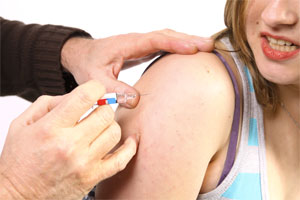
 Vaccines against the Human Papillomavirus (HPV), which causes over 99 per cent of all cervical cancers, have to be made cheaper to maximise their usage in developing countries, said cancer scientists and experts at a symposium on HPV vaccination in the Asia Pacific and Middle-East regions.
Vaccines against the Human Papillomavirus (HPV), which causes over 99 per cent of all cervical cancers, have to be made cheaper to maximise their usage in developing countries, said cancer scientists and experts at a symposium on HPV vaccination in the Asia Pacific and Middle-East regions.
“The World Health Organisation (WHO) has recommended three doses of HPV vaccine be given to girls between the ages of 10 and 13, just before the age of sexual initiation. That should be integrated with screening of older women for cervical cancer,” said Dr Linda Eckert, a scientist with the WHO Initiative for Vaccine Research.
Cervical cancer is the number one cancer among women in India, affecting 1.3 lakh women each year. Globally, 5 lakh women are diagnosed with it every year. Half of them die – that’s 2.5 lakh, or one woman every two minutes.
|
Cervical cancer factoids |
| * Infects 5 lakh women globally each year, 1.3 lakh in India * Kills 2.5 lakh women each year: one woman dies every two minutes * Accounts for 5 per cent of all global cancers * 10 per cent of all cancers among women globally * 15 per cent of all cancers in women in developing countries * HPV vaccines offer 70 per cent protection against cancers * HPV causes cancers of cervix, vulva, vagina, anus, larynx (oral) and oro-pharynx * Cervical cancer screening has reduced cervical cancer deaths in developed countries * 25 developed countries offer public funding for cervical cancer vaccination |
HPV is the most common sexually-transmitted disease and infects one in 10 women worldwide. Out of HPV’s over 100 strains, two – HPV 16 and HPV 18 – cause over 70 per cent of cervical cancer cases, followed by HPV 45, 53 and 58.
“Targeting HPV is essential to target cervical cancer”. Now, two vaccines — Merck’s Gardasil (against HPV 6,11,16 and 18) and GSK’s Cervarix (against 16, 18) – offer almost complete protection against the most dangerous strains.
“They need to be made available cheaper to make them affordable to developing countries, who need them the most,” said Dr John Clemens, director general, of the Internatioal Vaccine Institute, which is hosting an international symposium on HPV vaccination in the Asia Pacific and the Middle-Eastern Regions. Almost 80 per cent cervical cancer seaths take place in developing countries.
The HPV vaccine costs $125 per dose in the US, with the three-dose regimen priced at $375. Along with cost of storage and vaccination, the cost per person is well over US$400. “Current vaccines are expensive, but with WHO granting pre-qualification to Gardasil last week — Cervarix will follow soon — international funding agencies such as UNICEF can negotiate with manufacturers to lower prices for developing countries,” said Eckert.
Countries like India, with non-existent screening for cervical cancer, are likely to benefit the most. The two available vaccines don’t target all the HPV strains but offer some cross-protection to other cancer-causing strains.
“If you factor in the cross protection, the protection offered by vaccination is up to 75 per cent,” said Dr F. Xavier Bosch, chief, Cancer Epidemiology, Catalan Institute of Oncology in Barcelona.
“Where there is no screening at all, the benefits will be tremendous as it will protect women against cervical cancer for years to come. Studies have shown that strong protection remains for six years and indications are it will continue for a few years more after that,” she added.
© HT Media